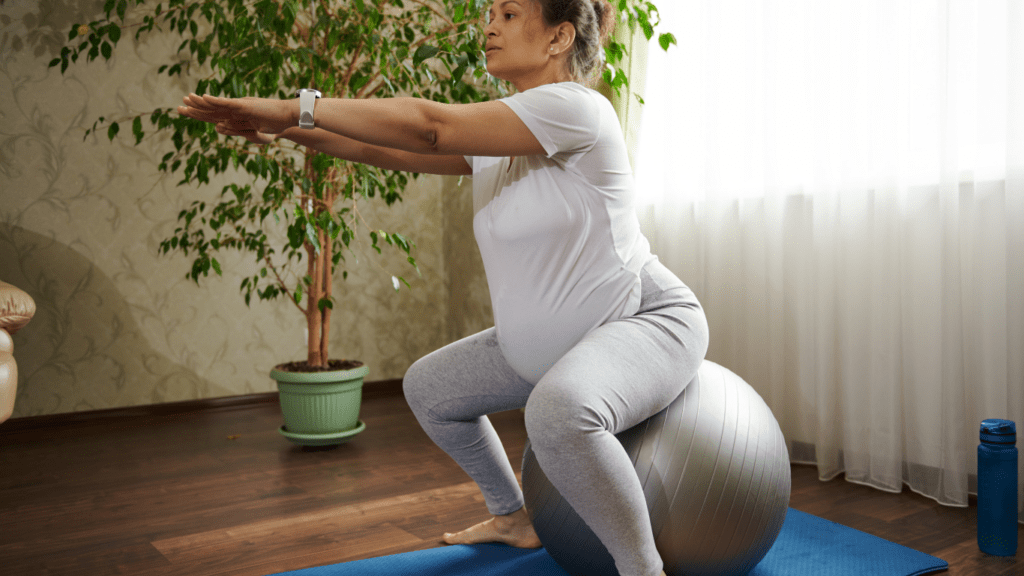Importance Of Pelvic Floor Health
Pelvic floor health is crucial for new moms. These muscles support the bladder, uterus, and bowel. Strong pelvic floor muscles help control urinary and bowel functions, improving daily comfort and preventing incontinence. Weakened pelvic floor muscles can lead to issues like pelvic organ prolapse, where organs drop from their normal position.
Research indicates that up to 50% of women experience some degree of pelvic organ prolapse after childbirth. Without preventive care, this rate increases, causing discomfort and affecting quality of life. Engaging in pelvic floor exercises helps mitigate these risks.
Pelvic floor health also impacts sexual function. Studies have shown that women with strong pelvic floor muscles report enhanced sexual satisfaction. Exercises like Kegels improve muscle tone, contributing to more fulfilling intimate relationships.
Incorporating pelvic floor exercises into daily routines benefits overall physical health. These exercises enhance core stability, which is vital for posture and balance. Moms engaging in regular pelvic floor workouts often experience fewer back pains and better physical endurance.
Proper pelvic floor health aids postpartum recovery. Strengthening these muscles helps reduce recovery time by promoting blood circulation and muscle repair. Quick recovery is imperative for new mothers managing new responsibilities and needing physical resilience.
Common Post-Pregnancy Challenges
New mothers often face several physical challenges after childbirth. Strengthening post-pregnancy muscles can help mitigate these issues.
Urinary Incontinence
Urinary incontinence affects many new moms. Symptoms include involuntary leakage during activities like coughing, sneezing, or laughing. Weak pelvic floor muscles often contribute to this issue. Consistent pelvic floor exercises can improve muscle strength and bladder control.
Pelvic Organ Prolapse
Pelvic organ prolapse occurs when pelvic organs drop due to weakened muscles. A common condition affecting up to 50% of women post-childbirth, it can lead to discomfort and pressure in the pelvic region. Strengthening the pelvic floor is essential for supporting these organs and preventing prolapse.
Diastasis Recti
Diastasis recti involves the separation of abdominal muscles, creating a bulge in the midsection. It’s prevalent among new moms, especially those with multiple pregnancies. Strengthening core muscles, including the pelvic floor, aids in reducing this separation and restoring abdominal strength.
Benefits Of Pelvic Floor Exercises
Pelvic floor exercises offer numerous advantages for postpartum recovery. First, these exercises significantly improve bladder control. Mothers often experience urinary incontinence after childbirth due to weak pelvic floor muscles. Strengthening these muscles alleviates this condition.
Second, pelvic floor exercises support pelvic organ health. Many women face pelvic organ prolapse post-childbirth, where organs like the uterus or bladder descend due to weakened support. Regular exercises enhance muscle strength, preventing prolapse.
Third, improved sexual health is a key benefit. Strong pelvic floor muscles increase sexual satisfaction by enhancing sensation and function. This helps build confidence and intimacy.
Fourth, these exercises aid in core stability by improving overall muscle tone and coordination. A strong core reduces back pain and supports better posture. This is particularly important as moms carry out daily activities involving lifting and bending.
Lastly, pelvic floor exercises speed up postpartum recovery. By boosting blood circulation and promoting muscle repair, these exercises help mothers regain strength quicker. A quicker recovery makes it easier to manage motherhood’s physical demands.
Strengthening post-pregnancy muscles through pelvic floor exercises ensures moms lead healthier, more comfortable lives.
Effective Pelvic Floor Exercises

Here are some effective pelvic floor exercises that can help strengthen post-pregnancy muscles. Each exercise has specific benefits for strengthening the pelvic floor and supporting overall recovery.
Kegel Exercises
Kegel exercises target the pelvic floor muscles directly, making them a foundational exercise for moms post-pregnancy. To perform Kegels, first, identify your pelvic floor muscles by stopping urination midstream. Once identified, contract these muscles for 5 seconds, then relax for 5 seconds. Repeat this 10-15 times per session, aiming for three sessions daily. This exercise improves bladder control and reduces the risk of urinary incontinence by enhancing muscle strength.
Bridge Pose
The Bridge Pose strengthens the glutes, lower back, and pelvic floor. Start by lying on your back with knees bent and feet flat on the floor, hip-width apart. Place your arms at your sides. Lift your hips towards the ceiling, squeezing your glutes and engaging your pelvic floor muscles. Hold for 10 seconds before lowering your hips back down. Perform 10-15 repetitions. This exercise not only strengthens the pelvic floor but also improves core stability and posture.
Squats
Squats are effective for building strength in the pelvic floor, thighs, and buttocks. Stand with feet shoulder-width apart. Lower your body as if sitting back into a chair, keeping the chest up and knees behind toes. Engage your pelvic floor muscles as you return to standing. Aim for 2-3 sets of 10-15 reps. Squats help reinforce pelvic floor muscles and overall lower body strength, beneficial for everyday activities.
Pelvic Tilts
Pelvic tilts engage the lower back and abdominal muscles along with the pelvic floor. Lie on your back with knees bent and feet flat on the floor. Press your lower back into the floor, tilting your pelvis upward. Hold for 5 seconds and release. Perform 10-15 repetitions. This exercise strengthens the pelvic floor, improves lower back flexibility, and aids in reducing back pain associated with weakened core muscles.
Tips For Incorporating Exercises Into Daily Routine
Consistency ensures effective results in pelvic floor exercises. Integrating these exercises into daily activities is easier than it seems.
1. Morning Routine
I start my day with a few minutes of Kegel exercises while brushing my teeth. This habit makes it easy to remember and fits seamlessly into my routine.
2. During Commutes
I practice Kegel exercises while driving or taking public transport. Focusing on muscle contractions during these idle times maximizes efficiency without adding stress.
3. While Sitting
I perform pelvic tilts or engage my core muscles while working at my desk. Setting an hourly reminder on my phone helps maintain consistency.
4. Before Bed
A short session of Bridge Pose right before sleeping helps relax my body and strengthens my pelvic muscles without disrupting my schedule.
5. Using Apps
Using mobile apps designed for pelvic floor exercises provides guided sessions and reminders. This keeps me on track and ensures correct technique.
6. With Daily Tasks
I integrate squats while picking up toys or lifting laundry baskets. These activities, combined with exercise, help tone my muscles efficiently.
7. Postpartum Groups
Joining a postpartum support group or exercise class adds motivation and accountability. These groups often provide valuable tips and shared experiences.
8. Tracking Progress
Keeping a journal to document exercise frequency and any improvements in bladder control or core strength provides motivation. Seeing progress over time encourages continued effort.
By making these exercises part of my daily routine, I strengthen my pelvic floor without disrupting my day.
Monitoring Progress And Signs Of Improvement
To track progress with pelvic floor exercises, I find it essential to set clear, measurable goals. This helps identify improvements and stay motivated. Setting goals like reducing urinary leaks from five times daily to twice can provide a tangible metric. Using a journal to log daily exercises and note any changes in symptoms helps maintain focus.
I look for specific signs to gauge improvement. Reduced instances of urinary incontinence indicate better muscle strength. Lessening of pelvic discomfort during activities like walking or lifting also shows progress. Another sign is an improved ability to contract and relax pelvic muscles, indicating increased control. Monitoring these markers helps me adapt my exercise routine for optimal results.
To validate improvements, I may consult healthcare professionals. Regular check-ups can confirm that my pelvic floor muscles are strengthening, and adjustments to my regimen can be made if necessary. Engaging with postpartum support groups provides additional feedback and motivation from peers on a similar journey. Sharing experiences and progress can offer valuable insights and encouragement.
Using mobile apps designed for pelvic floor exercises is another effective tracking method. These apps often provide progress reports and reminders, ensuring I stay consistent. Incorporating these tools into my routine boosts accountability and helps me stay on track.
By consistently monitoring progress and noticing signs of improvement, I can refine my exercise regimen and achieve better pelvic floor health post-pregnancy.
When To Seek Professional Help
Recognize persistent symptoms that signal the need to seek professional help. If urinary incontinence, pelvic pain, or discomfort during intercourse continues despite regular pelvic floor exercises, consult a healthcare provider. Painful or ineffective exercises may indicate improper technique or underlying issues.
Identify signs of pelvic organ prolapse. Symptoms like a bulge in the vaginal area, a feeling of heaviness, or difficulty with bowel movements should prompt a visit to a specialist. These could indicate prolapse severity, requiring professional evaluation and treatment.
Monitor your overall recovery. If postpartum recovery stalls despite consistent exercise, or you experience symptoms like back pain or abdominal muscle separation (diastasis recti), seek guidance. Physical therapists specializing in women’s health can offer personalized treatment plans.
Consult professionals for personalized advice. A healthcare provider can help manage symptoms and tailor exercises to your needs. Physical therapists can ensure exercises are performed correctly, optimizing benefits and avoiding injury.
Use available resources for additional support. Join postpartum support groups, attend workshops, or use mobile apps designed for new mothers. These resources can provide expert advice, shared experiences, and additional motivation through your recovery journey.




